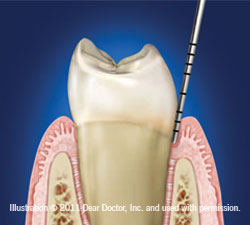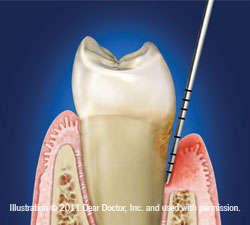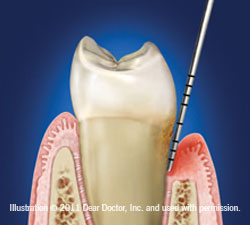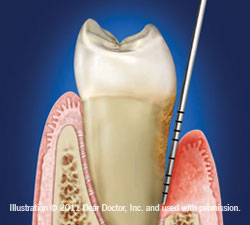It's a goal we all have: We want to walk into the dentist's office, hear that our teeth look great, get a routine cleaning, and then not have to think about going to the dentist again for another six months.
It can come as a shock when that doesn't happen. You might think you're taking great care of your teeth: You brush twice a day, you floss somewhat regularly, and occasionally use a mouthwash. So how can a dentist diagnose you with periodontal disease?
Your Lifestyle Affects Your Smile
Often, it's the choices you make every day that can lead to periodontal disease. You may have begun to skip brushing in the morning because you were in a rush to get out the door, or at night because you were so tired. You may be using a toothbrush that is more than three months old and its bristles are not as effective. You may not be flossing every day, so bacteria (plaque) builds up between your teeth and under your gum line, attaching to the root surface. After only 48 hours, the plaque can calcify and will be there until you have your teeth cleaned again, said Dr. Michael Quinn, a periodontist with more than 20 years of experience who practices at several Coast Dental offices in Georgia.
Small changes in our hygiene habits can add up to big problems for your mouth very quickly. At Coast Dental, the dentist uses x-rays and an oral examination to determine how healthy your teeth and gums are, following the classification system established by the American Academy of Periodontology (AAP). Over time, untreated gum disease causes the gum to separate from the teeth, forming a bacteria-filled pocket that becomes infected. Our clinicians use a tiny ruler called a probe to measure the depth of the gum tissue around each tooth, known as a sulcus, to see if a pocket has formed. As the disease progresses, the pockets become deeper and the treatments become more extensive, more expensive and more time-consuming. Periodontal disease is the number one cause of adult tooth loss in the United States; ignoring it could allow the disease to deteriorate the bone and gums so badly, teeth will need to be extracted.
 Healthy Mouth
Healthy Mouth
Here is an illustration of a healthy mouth. Clinical findings include 0-3 mm sulcus, no bone loss, pink and firm gums, no bleeding on probing and no root exposure. A doctor or hygienist typically can perform a routine cleaning.
 Gingivitis (Reversible)
Gingivitis (Reversible)
Here is an illustration of a mouth with gingivitis. Clinical findings include up to 4 mm pockets, red, swollen gums, bleeding on probing, inflammation, possibly plaque and calculus present, but no bone loss and no root exposure. This is the only kind of periodontal disease that is reversible, and a doctor or hygienist typically can perform a routine cleaning. In some cases, a more aggressive cleaning , such as a debridement, may need to be performed, especially if you do not floss or have not seen a dentist on a regular basis. A second cleaning may then be indicated to attain periodontal health .
 Slight Chronic Periodontitis
Slight Chronic Periodontitis
Clinical findings include 4-6 mm pockets, and could include bleeding on probing, pus present, plaque and calculus present, slight root exposure, bone loss and slight clinical attachment loss. The patient's treatment plan typically requires Scaling and Root planing and adjunctive medications / laser treatments and may require the patient to return more frequently for treatment.
 Moderate Chronic Periodontitis (Irreversible)
Moderate Chronic Periodontitis (Irreversible)
Clinical findings include 5-6 mm pockets, red, swollen gums, and could include bleeding on probing, pus present, plaque and calculus present, moderate root exposure, bone loss, moderate clinical attachment loss and loose teeth. The patient's treatment plan typically requires Scaling and Root planing and adjunctive medications / laser treatments and may require the patient to return more frequently for treatment. Some teeth may not respond to this treatment and a referral to a periodonist, a gum specialist, may be indicated.
 Advanced Periodontitis (Irreversible) Clinical findings include 6 mm or greater pockets, red, swollen gums, and could include bleeding on probing, pus present, plaque and calculus present, severe root exposure, bone loss, severe clinical attachment loss and loose teeth. The patient's treatment plan typically requires Scaling and Root planing and adjunctive medications / laser treatments and may require the patient to return more frequently for treatment. The general dentist may also refer the patient to a periodontist for treatment due to the advanced nature of bone loss.
Advanced Periodontitis (Irreversible) Clinical findings include 6 mm or greater pockets, red, swollen gums, and could include bleeding on probing, pus present, plaque and calculus present, severe root exposure, bone loss, severe clinical attachment loss and loose teeth. The patient's treatment plan typically requires Scaling and Root planing and adjunctive medications / laser treatments and may require the patient to return more frequently for treatment. The general dentist may also refer the patient to a periodontist for treatment due to the advanced nature of bone loss.
 Michael Quinn, DMD, has been a practicing dentist since 1987. He is a Board Certified Periodontist and provides periodontal services to patients starting at age 8. Special services include all periodontal services, bone grafting, crown lengthening, dental implants and restorations, endodontic surgery, extractions, gummy smile treatment, periodontal disease management, pre-prosthetic surgery, ridge augmentation, soft tissue grafts and sinus lift. He practices at several Coast Dental offices in Georgia including ones in Atlanta, Marietta, Fayetteville, Lawrenceville, and Stone Mountain.
Michael Quinn, DMD, has been a practicing dentist since 1987. He is a Board Certified Periodontist and provides periodontal services to patients starting at age 8. Special services include all periodontal services, bone grafting, crown lengthening, dental implants and restorations, endodontic surgery, extractions, gummy smile treatment, periodontal disease management, pre-prosthetic surgery, ridge augmentation, soft tissue grafts and sinus lift. He practices at several Coast Dental offices in Georgia including ones in Atlanta, Marietta, Fayetteville, Lawrenceville, and Stone Mountain.
Reviewed by: Michael Quinn, DMD
Reviewed by: Charbel Klaib, DMD
Reviewed by: Cindy Roark, DMD